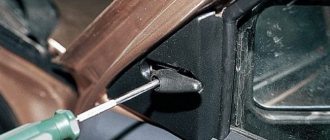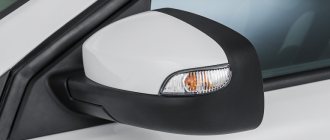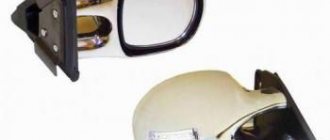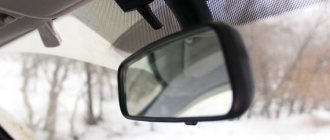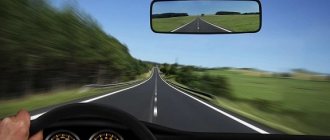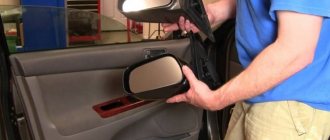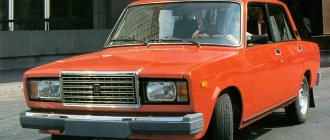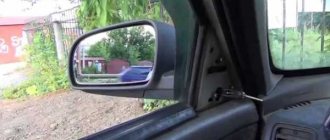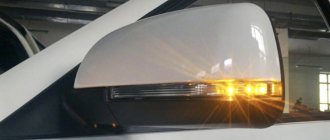How to glue a rear view mirror to a windshield
Many drivers make a big mistake when they are inattentive when choosing an adhesive for connecting a metal fastening element to glass. The most common erroneous option is to connect the rear view mirror to the windshield using ordinary Moment construction adhesive. In second place in popularity among incorrectly chosen products is double-sided tape.
It is important to understand that the adhesive material with which the rear view mirror clings to the windshield must:
Withstand the weight of the mirror, which consists of a metal mount, plastic parts and glass;
- Maintain its properties at increased vibration. Moment glue is not able to work in conditions of constant vibration, and on the next bump the interior mirror will fall off if you use it for fastening;
- Do not lose stickiness due to temperature changes. The windshield of a car is subject to serious temperature changes, which are partially transferred to the adhesive. Sun rays in summer and snow settling on the glass in winter should not affect the adhesive properties of the chosen product.
The properties listed above are inherent in epoxy resin, with which you can securely mount the rear view mirror to the windshield. But the problem with its use is that for high-quality fastening it is necessary to press the interior mirror to the glass for 10-12 hours, fixing it securely. Since this is quite difficult to do, it is better to use special means for gluing the rear view mirror to the windshield.
In automotive chemical stores you can find many different products designed to fix rear view mirrors to the windshield. Here is a list of the most popular and high-quality adhesive options:
Permatex 81840 or Permatex 81844. An inexpensive means for gluing a rear view mirror to the windshield. Among its advantages, one can note the presence in the kit of a special napkin for degreasing the surface.
Most often, the price of glue for interior glass depends on the configuration and volume of the substance.
Possible problems when gluing car mirrors
Often, when independently installing a torn mirror, a car enthusiast is faced with a number of troubles, which it is better to know about in advance.
Poor quality glue
A low-quality composition has poor adhesion to smooth substrates, and therefore is not able to hold them in the desired position for a long time. In addition, second-grade adhesives quickly crack under stress and vibration, as a result of which the mirror can fall off while driving.
Cold surfaces
If the work is carried out in winter, it is worth warming up the parts to be glued in advance, for example, using a regular hair dryer. This technique will help increase the adhesion of materials and extend the service life of the seam.
Violation of technology
If the work is done incorrectly, the mirror will not be attached to the glass securely enough. Most often, beginners ignore degreasing the base, sanding it with sandpaper, and completely removing the old adhesive. All these violations entail a decrease in the quality of the adhesive joint.
Start of use too quickly
Before using the machine, you need to wait the time specified by the glue manufacturer before its final polymerization. If the seam is subjected to vibration and stress at an earlier time, the mirror may become detached.
How to glue an interior mirror to the windshield
Using the correct adhesive does not guarantee that the rear view mirror will remain securely attached to the windshield for a long time. In order for the salon mirror to hang for years in its proper place, it is necessary to glue it correctly:
- Drive your car into a garage or other warm room if it's cold outside. The glue will show its properties better if the ambient temperature is about +20 degrees Celsius;
- Next, you need to decide where the mirror will be glued to the windshield. It is optimal for it to be in the middle, but in each situation it should be based on individual preferences and the design of the rear seats;
- After this, you need to clean the bonded surfaces from any glue residue. Dried glue can be removed from glass using a knife or razor. To clean a metal fastener, it is better to preheat it with a hairdryer, and then scrape off the remaining glue with a knife;
Important: Be sure to read the instructions on the adhesive for its use.
It is worth noting that the glass should be hung on the mount no earlier than 24 hours after gluing it. It is advisable to securely fix the mount on the glass while the adhesive dries completely. For example, you can use tape, plasticine or a magnet on the back of the glass to avoid the slightest movement of the surfaces being glued.
The circumstances in which you will need to remove your rear view mirrors can vary. For example, repairing or replacing cracked glass, purchasing new modified models, and even regular window tinting. In addition, you can install a heater in your car, as well as a monitor and a rear view camera. Removing a damaged mirror, disassembling it and gluing a new one with your own hands is not so difficult, as is installing devices more convenient than a regular reflector. To do this, arm yourself with your machine's operating manual and our instructions.
Tuning and installation of structures with pre-installed electronics
The installation methods described above are only applicable when replacing structures with similar ones. But for those who decided to slightly improve their car and, instead of the usual one, install a rear-view mirror with a camera, a video recorder, or additionally with a parking sensor monitor, it will not be possible to make do with improvised methods and replace the structure of the house. The same applies to installing heating on the side mirrors and additional lighting. Here you will need the help of a specialist, because you will have to deal with the wiring. Since this electrical device was not in the car before, the wiring will need to be correctly installed, secured, and then the operation of the device itself will need to be adjusted.
From the moment I bought the car, I almost had a problem with the rear view mirror. At first it appeared extremely rarely, and then it completely deteriorated. Perhaps the problem is familiar to some, but I don’t think I’ve seen anyone write about it. Over time, the mirror mount on the hinge becomes loose and it does not lock. For me it turned into the “I can’t hold on at all and look blankly down” stage. It needs to be corrected for the sake of appearance.
A long time ago I called the showdown. To which the answer was “Oh, yes! Standard problem, easier to replace." Well, I didn’t bother picking at anything, and then you know, I didn’t have time. So I recently came across a mirror and bought it. Moreover, his problem was just beginning, but compared to mine it was completely problem-free. Well, I installed it, and for the 5th day nothing has moved. I examined the mirror and it was clear that the hinge itself was coated with varnish, i.e. They also tried to repair it, but didn’t take it apart (I once poured instant glue into mine: it just doesn’t dry out and in the winter it worked just fine, but in the summer the glue apparently melted =)).
Read also: Grant wheel alignment angles
And so I took apart my mirror. And before I could figure it out, I came across a loose fastening of the platform, which was tightening the hinge. I tightened it right away and lo and behold! The fastening became absolutely unshakable!
In the photo, the black rectangle is the same mount that presses the ball. On two bolts that weaken over time. That's all about them actually.
But the mirror itself is essentially non-separable. The frame is soldered with dots. You might be able to see it in the photo. But in general, if you are careful, you can remove it. I removed it with a metal spatula. You can really shred everything with a screwdriver.
All that remains is to somehow glue the frame and return it to its place. I’m thinking about what to plant, because someday I’ll have to open it again. Apparently there is no way to do this without sealant =)
The circumstances in which you will need to remove your rear view mirrors can vary. For example, repairing or replacing cracked glass, purchasing new modified models, and even regular window tinting. In addition, you can install a heater in your car, as well as a monitor and a rear view camera. Removing a damaged mirror, disassembling it and gluing a new one with your own hands is not so difficult, as is installing devices more convenient than a regular reflector. To do this, arm yourself with your machine's operating manual and our instructions.
How to remove a rear view mirror
Mirrors of this type are designed to study the situation on the road behind the car. They can be divided into two categories:
- salon - installed inside the car;
- side - located on both sides on the front door pillars.
The interior mirror is located inside the car
side mirrors are located on both sides of the car
It seems that it could be easier than dismantling the mirror? In fact, this is not so easy to do, and the principle of dismantling can vary significantly between different brands and models. We will tell you about the most universal methods of removing, disassembling and installing internal and external ones. However, if any of the methods described here do not work for you, check your machine's owner's manual. Today, many automobile companies make all such processes much easier: perhaps, instead of unscrewing bolts and bending terminals, you only need to press a small button or pedal.
Required Tools
In order to remove the mirror, you do not need any specific or hard-to-reach tools. As a rule, everything you need can be found in any motorist’s garage.
- a set of screwdrivers (most likely, only figured and flat ones will be useful);
- wrench depending on the size of the bolts;
- household hair dryer for removing the mirror element.
Add to this set skillful hands and the desire to do everything efficiently, and you can get down to business.
Mirror removal process
Salon
Interior mirrors can be installed in a variety of ways depending on the make, model, and year of your vehicle. There are two methods that are used most often.
- Installation into the car ceiling using bolts or self-tapping screws.
- On the windshield using glue or suction cups.
Thus, on many domestic cars the assistant device is installed using ordinary bolts, which greatly simplifies the dismantling process. To do this, you just need to unscrew the bolts after removing the plug.
in order to remove such a mirror, you just need to unscrew the bolts
The situation can become more complicated if the mirror is mounted on a bracket glued to the glass. First of all, check whether it is possible to separate the bracket itself and the platform glued to the glass. On most cars, they are separated by moving the clamps or turning in a certain direction.
If this is not possible, you will have to resort to a radical method and remove the bracket along with the windshield. The fact is that the glue holds the elements very firmly, so when you try to separate the mirror, you may accidentally damage the glass.
Before you begin this process, take a look at your vehicle's manual: it should detail the process of removing certain components. Remember that buying a new windshield will cost you a lot.
You most likely will not be able to separate the bracket platform from the mirror on your own, so it is better not to risk it and contact a special salon. Especially if you are dismantling it for future tinting. However, if you decide to do it yourself, be prepared that a trace of glue will remain on the glass.
Gluing side mirrors
In some cases, the mirror element may peel off from the base itself, but remain intact. If you notice the problem in time, it can be fixed without much difficulty. Gluing an element with regular superglue cannot be called a reliable method. Rain, snow, car washes, and sun will quickly deteriorate the adhesive joint. You need to choose any of the above compositions or buy a neutral adhesive-sealant at a hardware store. The procedure for restoring the mirror will be as follows:
- remove the remaining plate from the part body;
- slightly sand the factory tape that is inside;
- degrease the mirror plate and base;
- apply glue or sealant, fix the elements;
- remove excess glue that has come out along the edge;
- squeeze the part with clothespins or special clamps.
Double sided tape
This tape is sold at any hardware or automotive store. However, professionals do not recommend using it, because such a mount cannot be called reliable. Scotch tape is used as a temporary measure if high-quality glue is not available.
Acrylic glue
Products based on acrylic copolymers have high adhesion to smooth substrates. With their help, it is quite possible to stick on a side-view mirror if it breaks. Typically, the part can be used 1-3 days after applying the glue. Primary fixation takes a minimum of time (about 60 seconds).
Sealant "Auto glue"
This all-purpose clear adhesive is designed to bond any materials used in automotive manufacturing. It is ideal for joining dissimilar substrates that have different coefficients of thermal expansion.
Using “Auto Glue” you can glue side mirrors, since it can easily withstand shock loads, vibration, frost and temperature increases, and exposure to technical fluids.
Disassembling the rear view mirror
Salon
In order to disassemble the internal, you will need special picks and push-ups. The case is divided according to the same principle as a mobile phone or control panel to replace the battery.
- Find the junction of the body and the mirror part.
- Insert the wringer into this area and press firmly. A gap should form on the housing.
- Carefully walk the pick along the entire gap and divide the body into two parts.
- Remove the mirror. All the elements you need will be located under it.
Disassembly process on video
Lateral
Once you have separated the side mirror housing from the car body, it should be disassembled. First of all, you need to remove the mirror element. This process may not be the same for different brands, however, the following procedure is most often used.
- Use a regular household hairdryer to thoroughly heat the junction of the reflective element with the body. The temperature of the air flow should not be too high, so a technical hair dryer will not work here.
- Using a flat-blade screwdriver or a small spatula, pry the mirror away from the housing. On some models, at this stage you need to bend the terminals. To avoid damaging the glass, you can wrap a screwdriver or spatula with electrical tape or a soft cloth.
- In some designs, to separate it, you need to lightly press it in the center and, as it were, push it to the side. After this, the reflective element can be removed with careful movements.
- Then remove the center screw from the plastic frame (if equipped).
- All side mirror mechanisms are located under the frame. Using a screwdriver, you can unscrew any of them and put them in place. You can independently divide the structure into all its component parts, including adjustment and folding motors.
Video: process of disassembling the side mirror
The mirror is assembled in the same way, but in reverse order.
How to secure and how to glue a new one
If you have successfully dismantled the mirror yourself, then returning it back will not be difficult. As a rule, all actions are performed in reverse order.
But you should pay special attention to the selection of glue, since not everyone is suitable for this process.
it is necessary to choose the right adhesive for attaching the mirror to the windshield
Glue selection
There are three types of compositions for gluing mirrors:
- chemically cured;
- light-curing;
- compositions based on epoxy resin.
A composition with resins will work well only if it is allowed to dry properly. This usually takes from 10 hours to a day. In this case, the part must be pressed tightly at all times. This approach is not very convenient, so such products are not used in everyday life.
Light-curing mixtures operate when exposed to special ultraviolet lamps. This is one of the most common methods in production. However, if you are not the happy owner of a lamp, you should not purchase such a composition. Sunlight, especially diffused light, is not able to have a sufficient effect.
For these reasons, chemically cured compounds are the most popular. A special hardener starts the polymerization process. As a rule, they consist of the glue itself and an aerosol activator, although one-component compositions are also found.
Please note that some materials cannot be used to glue the mirror.
- household superglue;
- double-sided adhesive tape.
The adhesive component of both materials has such a composition that when used on glass or metal, it will not be able to harden completely. High air temperature inside the cabin or heating of the glass from sunlight will soften it and the mirror will fall off. You can use household adhesives only if the mirror fell completely unexpectedly, and now you need to urgently get to a car service center.
I tried it with superglue three times. I confirm: it doesn’t last more than a week.
Max
https://homo-habilis.ru/v-garazhe/223-chem-prikleit-zerkalo-zadnego-vida-v-avtomobile
How to stick to windshield
Having selected the appropriate glue, you can begin returning the rear view mirror to its rightful place. Choose a warm day for this or install a heater in the garage: the air temperature should be between 20 and 25 ° C.
process of applying glue to the holder platform
- Clean the holder platform of any old adhesive residue.
- Lightly sand the surface of the holder to improve the adhesion effect.
- In the same way, sand the area of the windshield where it is glued.
- Degrease the holder and glass area.
- Apply a thin layer of glue to the holder.
- Spray a special activator onto the place where the part is attached.
- Place the adhesive side of the part onto the glass. Try to follow the trail left from the previous time.
- Press the mirror firmly against the glass and hold for the time indicated on the package.
- After making sure that the part is firmly in place, clean the mirror from any remaining activator and glue around the holder.
- Reinstall the windshield (if you removed it) according to the owner's manual.
Ready! If you followed all the instructions carefully, the mirror looks like it was installed at the factory or at least in a car repair shop.
Be extremely careful and attentive! A crookedly glued mirror cannot be moved, so you will have to start the whole process all over again.
How to install on bracket
If during dismantling you did not separate the bracket platform from the glass, it will be even easier to assemble it. To do this, find a fixing element: it may be a screw or a latch. After this, connect the bracket leg to the platform.
There are also special brackets that are not glued to the glass, but are installed on the ceiling or other elements of the car, for example, on sun visors.
Glue that will suit
When choosing how to glue the rear view mirror to the windshield, you can get confused about the manufacturers and names of adhesive compositions. To make it easier to make a choice, you need to familiarize yourself with the most popular and effective means.
These include several names:
- Loctite - according to reviews from satisfied car enthusiasts, this is the best adhesive in its class. The finished connection has a high strength index and is resistant to prolonged exposure to vibration. The best names are 37438, 319.
- Permatex. Another adhesive compositions for cars that have an optimal price/quality ratio. If the glue is applied correctly, the mirror will remain motionless on the glass surface for a long time. The hardened substance is resistant to vibrations.
- Domestic manufacturers also produce high-quality adhesive compositions. Among them, two names stand out - AN, KR.
- Another well-known glue is 3M. Supplemented with a liquid activator to obtain an adhesive mass.
- Abro glue for rear view mirror. It is a quick-setting adhesive composition with which you can obtain a reliable connection in a short period of time. Holds different materials firmly together. For glass, the modification RV-495-R is usually used.
- Poxipol is an epoxy adhesive that is popular in driving circles. It is valued for its efficiency and durability. The cost of the composition is above average.
- DoneDeal is one of the popular two-component compounds that can be found in car dealerships. Low cost makes it more attractive to drivers.
- IMG - adhesive for rear view mirrors. The instructions say that it is used for professional work. Bonds the metal brackets of the rear view mirror holders to the car windows. The two-component composition sets in 1 minute and resists UV radiation and temperature changes. Able to withstand strong vibrations and lifting up to 150 kg/cm², resistant to windshield wipers. They can also be used to glue the rotary clamps of the side windows.
When deciding how to glue the rear view mirror, it is permissible to consider the option of using regular universal epoxy resin. The connection will be reliable, however, it is not entirely convenient to work with this type of adhesive. It hardens in no less than 10 hours.
How to glue a rearview mirror to a windshield
Initially, you need to select an adhesive composition. When the means for repair work has been selected, you should familiarize yourself with how to glue the rear view mirror to the windshield. To do this, there are step-by-step instructions on the adhesive packages. In any case, the general installation technology using glue will be presented below.
Installation of mirrors with additional functions
Modern devices not only reflect, but also have a number of additional functions. You can equip them with heating, or even install a camera with a monitor.
Heated
The heating function is very convenient for external side mirrors, since thanks to it they will not fog up in high humidity and will not become covered with a crust of ice in frosty weather.
The heating element in the mirrors will help prevent fogging and icing
Possible malfunctions and their elimination
After independently dismantling, disassembling and installing a modified mirror, some problems may arise. Very often, incorrectly glued mirrors fall off at the most unexpected moment, which can lead to an accident.
What to do if the mirror comes off
The interior mirror may fall off due to physical impact or on its own. The main reason that the structure with the bracket does not stay in place is the wrong glue. If you chose epoxy, the platform holder was probably not locked in one position long enough. The same problem could occur if you used a light-curing product without special UV lamps. Household glue will also not give a good result: temperature changes and active vibrations of the car can lead to the mirror coming off while driving.
To fix this, the structure must be returned to its place and glue with a chemical hardener must be used.
Sometimes the platform with the bracket may fall off along with a piece of glass. This means that microcracks have already formed in it, which can spread throughout the rest of the glass. In this case, contact a car service: specialists will be able to carry out diagnostics and tell you how necessary it is to replace the windshield.
Nowadays you can find brackets with special suction cups on sale. They don't hold as tightly as the adhesive ones, but you can remove them and put them back in place repeatedly without fear of damaging your windshield.
What to do if it's cracked
A cracked mirror can cause a lot of inconvenience to a car owner. A serious crack can distort the image, and therefore make it difficult to assess the real distance to the object behind. This problem can occur in both the interior and side mirrors. Most often this happens during improper dismantling or installation. Although the reasons may be different: for example, a sharp pebble flying out from under the wheels, careless owners of neighboring cars, and even ordinary hooligans.
Be that as it may, the reflective element should be replaced. To do this, carefully remove the mirror from the housing and install a new one. Carefully follow the instructions for disassembling and reassembling the part. If you are not sure of your actions or are afraid of damaging the element again, contact a specialized workshop. The mirror replacement service does not cost very much, but it will help save you nerves and money on unsuccessful attempts.
Requirements for glue for mirrors
When choosing a suitable product, even a high-quality one from a well-known brand, you should make sure that the composition is intended not just for glass, but specifically for mirrors. The fact is that some of them may contain components that destroy the amalgam (reflective layer), which over time will lead to the appearance of stains on the mirror surface. Also, the fastening composition should not contain acids or alkalis.
When choosing, the material of manufacture and the specifics of the room in which the mirror will be located are no less important. Since the dimensions of the glass change with temperature changes, an adhesive should be used for bathtubs and showers that not only withstands high humidity, but is also not afraid of cold and heat. If it is not flexible enough, a hard substrate will form on the surface after drying, which may result in the glass cracking. Accordingly, the mirror will hold securely only if the adhesive composition has good elasticity and adhesion.
Adhesive types fall into two categories: neoprene and acrylic, each with its own properties. Neoprene contains rubber, so it has a strong odor but good adhesion. Acrylic is environmentally friendly, but cannot be used everywhere. Water solubility makes it undesirable to use in rooms with high humidity, such as the bathroom and kitchen.
Requirements for high-quality glue for mirrors:
- No toxic substances, alkalis or acids in the composition.
- High level of adhesion to various materials.
- Light or transparent color.
- Fast drying time.
- Elasticity.
The cheapest option is solvent-based glue. Silicone is chemically neutral and provides good adhesion. But their drying time is slightly longer. Therefore, it is easiest to work with a fastening agent that has a hybrid composition. Its high cost is more than compensated by a high-quality connection.
The glue should be intended not just for glass, but specifically for mirrors
The glue must be resistant to changes in temperature and humidity
